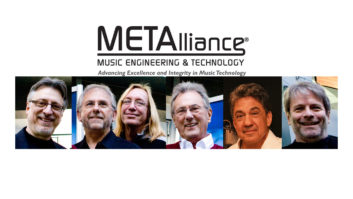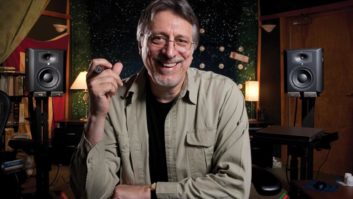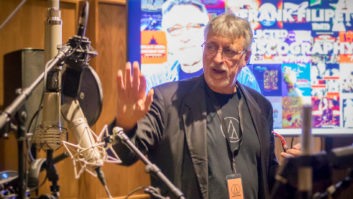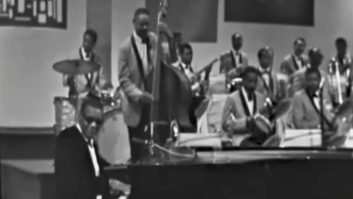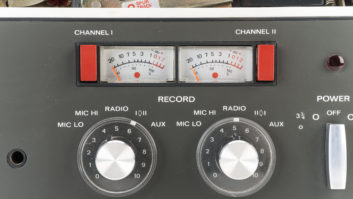After helping build Right Track Studios into the powerhouse that it is — and using its rooms to do the lion’s share of his work — independent producer/engineer Frank Filipetti has made it official: He is now a partner in the famed New York facility. Filipetti’s decision to take a financial stake in Right Track was spurred by studio owner Simon Andrews’ plans to build a colossal tracking room on the west side of Manhattan.
“One reason I had never gone with a studio is I wanted to maintain my independence,” says Filipetti. “I wanted whatever client I was working with to know that I was working at Right Track because I wanted to, not because I was forced to and had a stake there. But I think after 20 years, people have realized that I happen to like the place. I will remain independent on projects, but I will become a partner in this facility because I believe in it.”
When clients enter the new Right Track Studio — on West 38th Street near the Jacob Javits Convention Center — they should have no trouble believing that Filipetti would be working there, whether or not he was a principal in the studio. After all, it will be the largest tracking environment New York has seen in years, and easily one of its most lavishly appointed.
“Since the big studios of the ’50s, ’60s and ’70s have left, there hasn’t been anything in Midtown Manhattan that didn’t involve some sort of compromise,” says Filipetti. “After seeing rooms in L.A. and London, I wanted a room that had the kind of mass that’s going to allow you to go in there with a symphony and still have the isolation you may want for a Broadway show. I wanted a room that really spoke for itself.”
As a long-established independent who has chosen to align himself with an existing facility, Filipetti joins the likes of Chuck Ainlay and Jack Joseph Puig, who have made similar arrangements at Soundstage Studios in Nashville and Ocean Way in Los Angeles, respectively. Filipetti’s venture is especially interesting given that he almost went in the opposite direction — establishing his own, personal facility the way mix specialists Bob Clearmountain and Mick Guzauski have done in recent years. “Around 1998, I started entertaining the idea that I’d love to have my own studio,” says Filipetti. “I looked at what Bob and Mick had done and started fantasizing about a similar situation. I even found a place I was interested in and had come to a decision that I would purchase it. It was a residential studio with a brilliant tracking room and plenty of space. At that point, 80 percent of what I was doing was mixing, so I figured I could do that at my own studio near my home [in a northern suburb of New York City] and use Right Track for tracking and overdubbing.”
Concurrently with Filipetti’s search for his own studio, however, Andrews had lined up financing to build an unprecedented tracking/mixing room to address the needs of New York’s film scoring and theatrical communities, which grew substantially in the ’90s. The idea was not new to Filipetti. In fact, he had closely advised Andrews on every major move Right Track had undertaken since joining in 1980, including the move from its original location on 24th Street to its current site on West 48th Street in Midtown, and the console choices and specifications of all three of its rooms. Along the way, Andrews and Filipetti periodically discussed the possibility of building a large tracking space.
“Simon and I had been talking about this for at least 10 years,” says Filipetti. “In the late ’80s and early ’90s, we had Studios A and B running, and we realized that, without paying too much attention, we had come up with a couple of very successful rooms. Not that we didn’t spend a lot of time analyzing things, but our ideas meshed, some by design, some by serendipity. We realized that, between us, we had the ability to put together amazing-sounding rooms, and they were very successful.
“We decided about that time that the only real problem we were facing in the structure of both A and B — the one thing we were missing — was ceiling height,” he continues. “We started entertaining the idea of raising the ceiling in Studio A, but it would have entailed shutting down the rooms. Plus, at that time, space became available to build Studio C, so we scrapped the idea of making big architectural changes to the existing rooms and decided to try to find a new location that had ceiling height and floor space. We went through several things from there, including negotiating with people at existing facilities about merging, but none of that worked out. Then we got involved with building Studio C, and it turned into another very successful room.”
Starting in the mid-’90s, Filipetti’s career took off with such projects as the Grammy-winning James Taylor album Hourglass, the Pavarotti & Friends series, Hole’s Celebrity Skin, and projects by Barbra Streisand, Jim Steinman and Carly Simon, among others. With such a demanding schedule, there seemed to be little time left in Filipetti’s days to think about building a new studio. On the other hand, his success meant he was doing bigger and bigger projects, including orchestral and cast-album dates, many with longtime associate Phil Ramone. “On some of those projects I did with Phil, like A Funny Thing Happened on the Way to the Forum and Passion, I started thinking about how great it would be to find a big room to do that sort of stuff,” says Filipetti.
So, faced with a choice between setting up his own shop away from the city or joining Andrews in building a historic tracking/mixing studio, the latter scenario proved too enticing for Filipetti to pass up. “As excited as I was about the prospect of having my own place, this situation gives me even more excitement,” says Filipetti. “This room is something New York hasn’t seen in quite a while.”
Another factor that tilted the scales toward joining Right Track for Filipetti is that he already considered the studio his home. Far from being strictly a business venture that happened to work for both parties, Filipetti’s relationship with Right Track had always embodied a perfect symbiosis between client and studio. “I started out at Right Track,” says Filipetti, who was an aspiring singer/songwriter before fate turned him into a world-class engineer and producer. “Simon gave me my first opportunity to engineer, and we became fast friends early on. I used to do my songwriter demos for Screen Gems at Right Track and I cut my album there. When all that fell through, I went to Simon and asked him if he would let me engineer for him. I was 30 years old at the time, so I asked him if I could do it without being an assistant, and he let me. So I started engineering gigs for him [circa 1980,] and within six months, I was chief engineer.”
In 1983, Filipetti — along with many up-and-coming engineers at the time — went independent. However, unlike most of his peers, he stayed close to his roots. “I went indie, but Right Track was my home,” he says. “I’d worked with Simon on the design of the first room as well as Studio B, both of which were successful. By the time I left, the two of us had designed a couple of studios together, and they were my favorite rooms. I did most of my work in those rooms, and they reflected a lot of what I thought studios should be. So, even though I wasn’t a partner, I was always consulted about what gear to buy. For instance, soon after I went indie, I was in London with Peter Asher at the APRS show and I saw my first Solid State Logic console. I brought the information back to Simon and he put one in Studio B, and it was immediately successful.
Now, almost two decades later, Andrews and Filipetti are preparing to turn heads with their latest creation. With a footprint of 85 feet by 55 feet and a ceiling height of 35 feet, the new Right Track studio will boast dimensions that exceed those of even the largest music tracking rooms in the city. Although there are TV soundstages that are larger, they are not optimized for music tracking and mixing the way the Right Track room will be. Filipetti estimates that the studio will be able to hold a 60- to 70-person orchestra with a choir. “There have not been any compromises made anywhere,” says Filipetti. “Down to some innovative cable interfaces, it will be a first-class facility all the way.”
For an engineer who has won tremendous acclaim — and three Grammys — for recordings mixed on the all-digital Neve Capricorn console at Right Track’s Studio B, Filipetti’s and Right Track’s choice of a Solid State Logic 9000 J board for the new room may raise some eyebrows in the industry. Filipetti explains the rationale for investing in analog technology after helping lead the trend toward digital: “Although I’ve worked almost exclusively on digital consoles for the past several years, digital consoles are still developing. We now have new standards and new formats, and a large-format console to do this sort of thing is three to four years down the road.”
In their quest to find the ideal analog board for their new studio, Filipetti and Right Track manager Barry Bongiovi scouted world-class facilities in Los Angeles and London and returned to New York with a clear vote. “We talked to many engineers, and the consensus was that the 9k with the scoring panel was the way to go,” says Filipetti. “It’s universally recognized as being a fantastic-sounding console, and it’s got the track record in the industry and the ability to do everything we need it to do.”
Another of the 9000 J’s attributes is its ability to handle 5.1 channel mixing projects, which Filipetti hopes to cultivate at the new facility. “Although we are billing this as an orchestral tracking room, that’s not all we want to do there,” he says. “We are trying to make this the finest stereo and 5.1 mix room on the planet. We’ve designed the control room to be a sophisticated mixing environment. Surround sound won’t be an add-on — it’ll be a full-fledged 5.1 and cinema mixing room, and for the rock and hip hop mixers, we’ve developed a scoring panel that not only can be bypassed electronically, but can actually be removed from the console entirely.”
For smaller, rock ‘n’ roll sessions that don’t need the entire tracking area, the room will be partitioned according to the needs of the client, according to Filipetti. Similarly, the headphone system will be able to be customized for various uses. “Something that always bugs me about a lot of studios is that the headphone system always seems like an afterthought, when in reality the headphones and the communication system are the single most important thing in a studio,” says Filipetti. “We’ve designed the headphone system from the ground up to provide every facility you could ever want.”
Hearing Filipetti expound on the virtues of the new Right Track studio, one can’t help but sense that the room is the culmination of his lifelong ambition to build a recording paradise where no detail is overlooked and no expense spared.
“This is the kind of studio that you dream about,” Filipetti concludes. “With all the renewed interest in Broadway and film, and with the revitalization of New York, the timing seemed right.”
Paul Verna is Mix‘s N.Y. editor.

